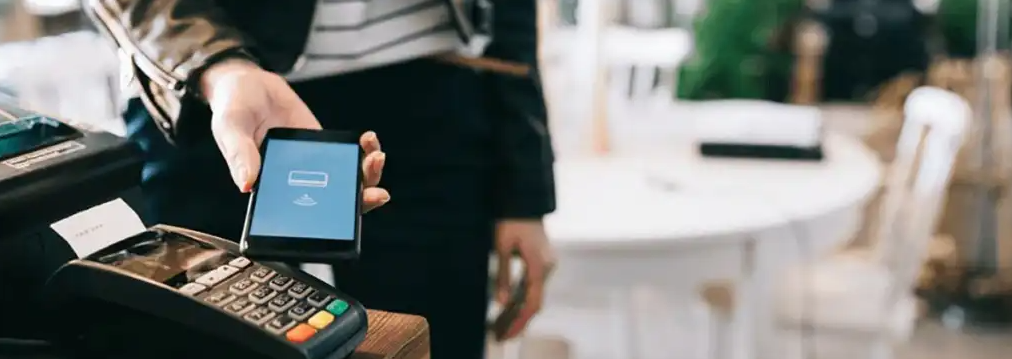What is a digital wallet & how does it work?

As technology continues to evolve, devices like smartphones and smartwatches have become helpful for completing a range of everyday tasks. With just a few clicks or taps, you can take care of countless daily tasks. And that includes making purchases without needing your physical debit card. One way to do this is by using a digital wallet. Learn more about what digital wallets are, how they work, and how they can simplify your money management.
Key takeaways:
- Digital wallets are electronic versions of your physical wallet and allow you to pay for things without using physical cards or cash.
- Popular digital wallets include Apple Pay®, Google Pay™, Samsung Pay®, among others.
- You can use your digital wallet to pay in stores, online, and within apps for convenience where you shop.
- Blue Grass Valley Bank customers can link their debit card to their digital wallets to make on-the-go purchases faster and more securely.
Your digital wallet can often hold your debit cards, credit cards, loyalty cards, or even concert and airline tickets. This helps make it easier for you to access funds and information you need when you need it. Plus, it can eliminate the clutter of several plastic cards and speed up transactions with a simple tap, click or swipe of your finger.
How to use a digital wallet
One of the benefits of a digital wallet is access to quicker transactions. And that can come in handy, especially if you’re out and about and realize you left your physical wallet at home. Many retailers now have updated payment terminals that are compatible with contactless payments like mobile wallets and contactless cards.
Here are just a few ways you can use your digital wallet:
- Online: Digital wallets can make online shopping easier by automatically filling in your information for you. This way, you don’t have to enter your info each time, and you can check out in just a few clicks.
- On the go: Simply pay with your mobile wallet on your smartphone, smartwatch or other mobile device when you’re checking out in a store.
- In apps: Use your digital wallet for easier and more secure in-app purchases.
How does a digital wallet work?
Different digital wallets use different technologies to process payments:
- Near Field Communication or NFC: This allows two devices to exchange information if they’re placed close to each other. Apple Pay and Google Pay use this technology. To use one of these digital wallets, the merchant must have compatible card readers at checkout.
- Magnetic Secure Transmission or MST: This generates a magnetic signal, much like when you swipe the magnetic stripe on a credit card. The signal is transmitted to the payment terminals card reader. Samsung Pay uses both MST and NFC technology.
Usually, for in-person payments, the customer’s mobile device communicates with the merchant’s payment terminal or device using NFC or MST. The customer then verifies the transaction with something like a password, a fingerprint, or facial recognition. The payment information is sent securely through the process of payment tokenization and the transaction is complete.
For online payments, it’s much the same. The only difference is that the digital wallet doesn’t need to communicate through NFC or MST, as it’s already installed in your browser or on your desktop.
Are digital wallets safe?
Safety may be one of the biggest concerns around the use of digital wallets. Who has access to your information? What if you lose your phone? Luckily, digital wallets utilize some of the latest security features to help keep your information safe and prevent both identity theft and card fraud.
The customer’s payment information is never shared directly with the merchant thanks to tokenization. Instead, a unique payment token, accompanied by a cryptogram that expires after one use. This makes it more difficult for fraudsters to view or use your financial details.
Strong Customer Authentication (SCA) is built-in by design for some digital wallets. The customer needs to verify every transaction with a password, fingerprint, or facial recognition, amongst other verifications. This makes them more secure than card payments, where identity verification isn’t always required.
And what if your device is lost or stolen? Thankfully, there are apps available that allow you to remotely lock or erase your device’s data. Using these apps and setting up additional security, like fingerprint ID and password protection, can help make your device more secure.
As with other forms of payment, digital wallets could be susceptible to hackers and scams. It’s important to practice good password hygiene, monitor your accounts, avoid making transactions on unsecured Wi-Fi networks and enable all the safety options mentioned above.
Want to add your card? Follow these easy steps!
Step One:
Follow the guidelines in your smartphone's wallet. The wallets itself will walk you through the process step-by-step. If you need a little extra help, please visit these guides for your particular smartphone:
Click for Apple Pay instructions
Click for Samsung Pay instructions
Click for Google Wallet instructions
Step Two:
Give us a call at either of our locations to confirm your status.
That’s it! Enjoy the freedom of secure debit purchases right at your fingertips!

